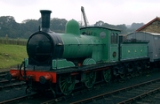
NER Class C1
Encyclopedia
The North Eastern Railway
(NER) Class C1, classified J21 by the London and North Eastern Railway
, is a class of 0-6-0
steam locomotive
. They were designed by T.W. Worsdell.
Originally 30 were built, but later 171 Class C
Compound locomotive
s were converted to simple operation.
Seventy-seven passed into British Railways ownership in 1948 and they were numbered 65025-65123 (with gaps).
. It was used at Beamish from 1975, pulling the restored NER Coach and the restored NER wagons between the Colliery Sidings and Station, until 1984 when it was declared unfit to run due to the Boiler certificate running out it last ran in December 1983. It then languished in the station yard, with No 14 (Hawthorn Leslie) or the Diesel shunter moving it to keep the motion from seizing up on occasion. It was on static display until 2004/2005 when it was removed to the North Norfolk Railway
for restoration to steam in 2007. Hopefully in the next ten to fifteen years she will come back to Beamish, though this may not be until 2025 at the very least.
Some locos were further rebuilt with superheaters, 19" bore cylinders, piston valves and Stephenson valve gear. Strangely, the superheaters were later removed from some of these locomotives.
North Eastern Railway (UK)
The North Eastern Railway , was an English railway company. It was incorporated in 1854, when four existing companies were combined, and was absorbed into the London and North Eastern Railway at the Grouping in 1923...
(NER) Class C1, classified J21 by the London and North Eastern Railway
London and North Eastern Railway
The London and North Eastern Railway was the second-largest of the "Big Four" railway companies created by the Railways Act 1921 in Britain...
, is a class of 0-6-0
0-6-0
Under the Whyte notation for the classification of steam locomotives, 0-6-0 represents the wheel arrangement of no leading wheels, six powered and coupled driving wheels on three axles, and no trailing wheels...
steam locomotive
Steam locomotive
A steam locomotive is a railway locomotive that produces its power through a steam engine. These locomotives are fueled by burning some combustible material, usually coal, wood or oil, to produce steam in a boiler, which drives the steam engine...
. They were designed by T.W. Worsdell.
Originally 30 were built, but later 171 Class C
NER Class C
These engines were designed to fill in the need for goods engines on the North Eastern Railway, and were built from 1886-1894. However, issues with reliability and fuel consumption led to all 171 being rebuilt to the simpler Class C1 class....
Compound locomotive
Compound locomotive
A compound engine unit is a type of steam engine where steam is expanded in two or more stages.A typical arrangement for a compound engine is that the steam is first expanded in a high-pressure cylinder, then having given up heat and losing pressure, it exhausts directly into one or more larger...
s were converted to simple operation.
Seventy-seven passed into British Railways ownership in 1948 and they were numbered 65025-65123 (with gaps).
Preservation
One, LNER 876 (BR 65033), has survived to preservation and is the subject of a bid to restore it to working order. The Locomotive was preserved in 1972 for Beamish MuseumBeamish Museum
Beamish, The North of England Open Air Museum is an open-air museum located at Beamish, near the town of Stanley, County Durham, England. The museum's guiding principle is to preserve an example of everyday life in urban and rural North East England at the climax of industrialisation in the early...
. It was used at Beamish from 1975, pulling the restored NER Coach and the restored NER wagons between the Colliery Sidings and Station, until 1984 when it was declared unfit to run due to the Boiler certificate running out it last ran in December 1983. It then languished in the station yard, with No 14 (Hawthorn Leslie) or the Diesel shunter moving it to keep the motion from seizing up on occasion. It was on static display until 2004/2005 when it was removed to the North Norfolk Railway
North Norfolk Railway
The North Norfolk Railway – also known as the "Poppy Line" – is a heritage steam railway in Norfolk, England, running between the coastal town of Sheringham and Holt, It cuts through the countryside to the east of Weybourne with views of its windmill and passes through the well preserved country...
for restoration to steam in 2007. Hopefully in the next ten to fifteen years she will come back to Beamish, though this may not be until 2025 at the very least.
Rebuilding
The rebuilding history of the class is very complex. All the Class C compounds were rebuilt as Class C1 simples and all were then re-classified as Class C (NER) and later Class J21 (LNER).Some locos were further rebuilt with superheaters, 19" bore cylinders, piston valves and Stephenson valve gear. Strangely, the superheaters were later removed from some of these locomotives.
External links
- http://www.lner.info/locos/J/j21.shtml

